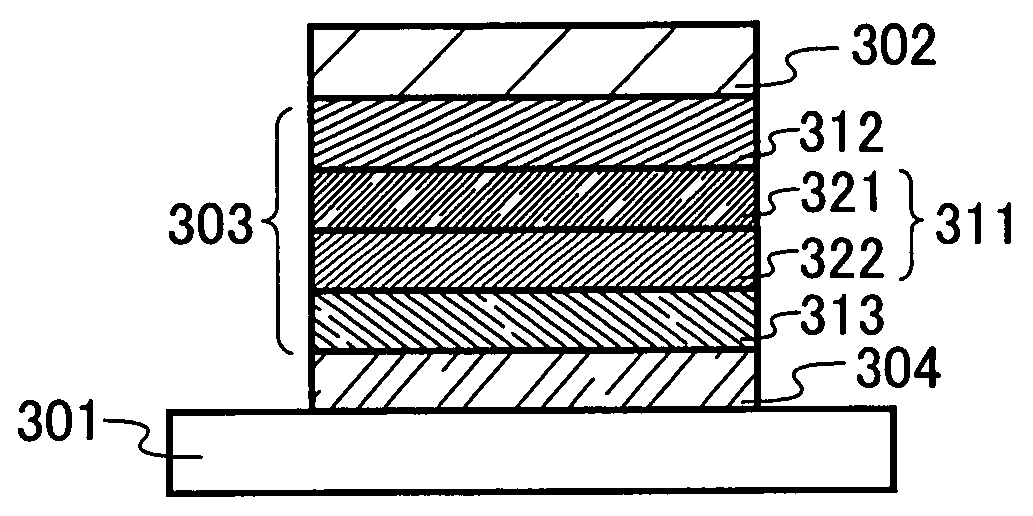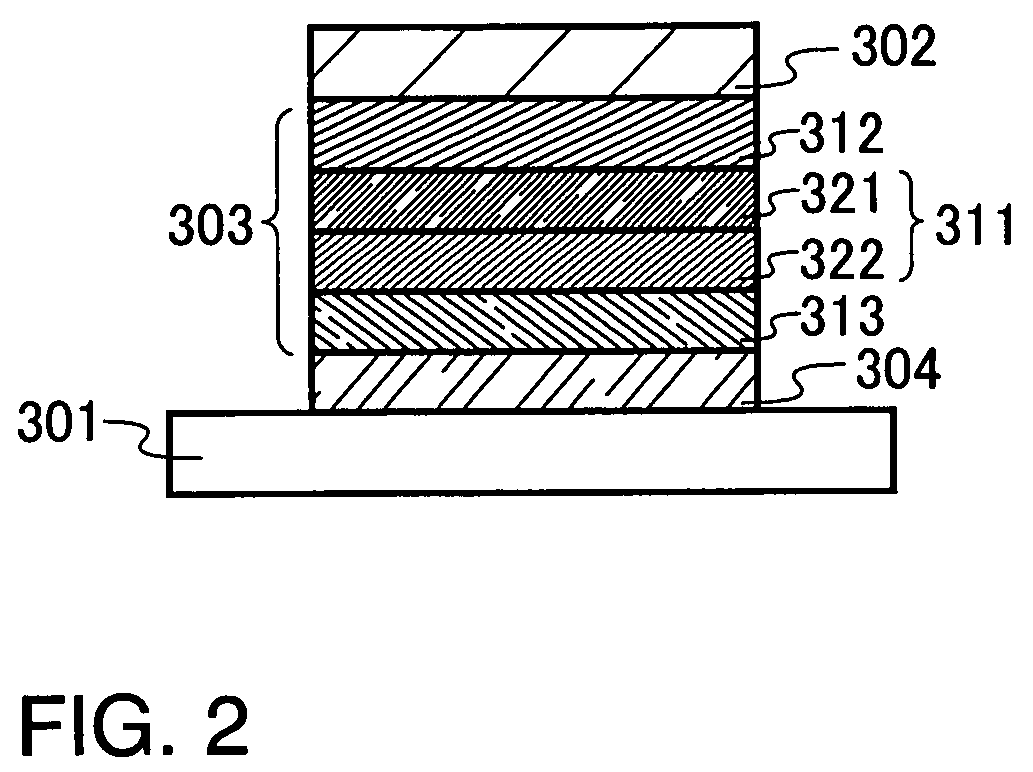Organic light emitting element
a light-emitting element and organic technology, applied in the direction of thermoelectric device junction materials, electrical equipment, semiconductor devices, etc., can solve the problems of difficult to obtain features and short lifetimes, and achieve the effect of longer lifetimes
- Summary
- Abstract
- Description
- Claims
- Application Information
AI Technical Summary
Benefits of technology
Problems solved by technology
Method used
Image
Examples
embodiment mode 1
[0066]One mode of a light-emitting element of the present invention will be described hereinafter with reference to FIG. 1A.
[0067]The light-emitting element of the present invention includes a plurality of layers between a pair of electrodes. In this specification, the plurality of layers formed between the pair of electrodes is collectively referred to as an EL layer.
[0068]In this embodiment mode, the light-emitting element includes a first electrode 102, a second electrode 104 and an EL layer 103 formed between the first electrode 102 and the second electrode 104. In addition, in this embodiment mode, the first electrode 102 serves as an anode and the second electrode 104 serves as a cathode. In other words, when a voltage is applied to the first electrode 102 and the second electrode 104 such that a potential of the first electrode 102 is higher than that of the second electrode 104, light emission can be obtained. Such a case will be described below.
[0069]The substrate 101 is us...
embodiment mode 2
[0110]Embodiment Mode 2 will describe a mode of a light-emitting element in which a plurality of light-emitting units in accordance with the present invention are stacked (hereinafter, also referred to as a stacked type light-emitting element) with reference to FIG. 3. This light-emitting element is a light-emitting element including a plurality of light-emitting units between a first electrode and a second electrode. As the light-emitting units, a structure similar to that of the EL layer shown in Embodiment Mode 1 can be used, In other words, the light-emitting element shown in Embodiment Mode 1 is a light-emitting element having one light-emitting unit, and Embodiment Mode 2 will describe a light-emitting element having a plurality of light-emitting units.
[0111]In FIG. 3, a first light-emitting unit 511 and a second light-emitting unit 512 are stacked between a first electrode 501 and a second electrode 502. To the first electrode 501 and the second electrode 502, similar electro...
embodiment mode 3
[0118]Embodiment Mode 3 will describe a light-emitting device having a light-emitting element of the present invention.
[0119]This embodiment mode will describe a light-emitting device having a light-emitting element of the present invention in a pixel portion, with reference to FIGS. 4A and 4B. FIG. 4A is a top view illustrating a light-emitting device while FIG. 4B is a cross-sectional view along lines A-A′ and B-B′ of FIG. 4A. A reference numeral 601 shown with a dotted line denotes a driver circuit portion (source side driver circuit); 602, a pixel portion; and 603, a driver circuit portion (gate side driver circuit). Moreover, a reference numeral 604 denotes a sealing substrate; 605, a sealing material; and 607, a space surrounded by the sealing material 605.
[0120]A leading wire 608 is to transmit a signal to be inputted to the source side driver circuit 601 and the gate side driver circuit 603, and receive a video signal, a clock signal, a start signal, a reset signal, and the ...
PUM
 Login to View More
Login to View More Abstract
Description
Claims
Application Information
 Login to View More
Login to View More - R&D
- Intellectual Property
- Life Sciences
- Materials
- Tech Scout
- Unparalleled Data Quality
- Higher Quality Content
- 60% Fewer Hallucinations
Browse by: Latest US Patents, China's latest patents, Technical Efficacy Thesaurus, Application Domain, Technology Topic, Popular Technical Reports.
© 2025 PatSnap. All rights reserved.Legal|Privacy policy|Modern Slavery Act Transparency Statement|Sitemap|About US| Contact US: help@patsnap.com



